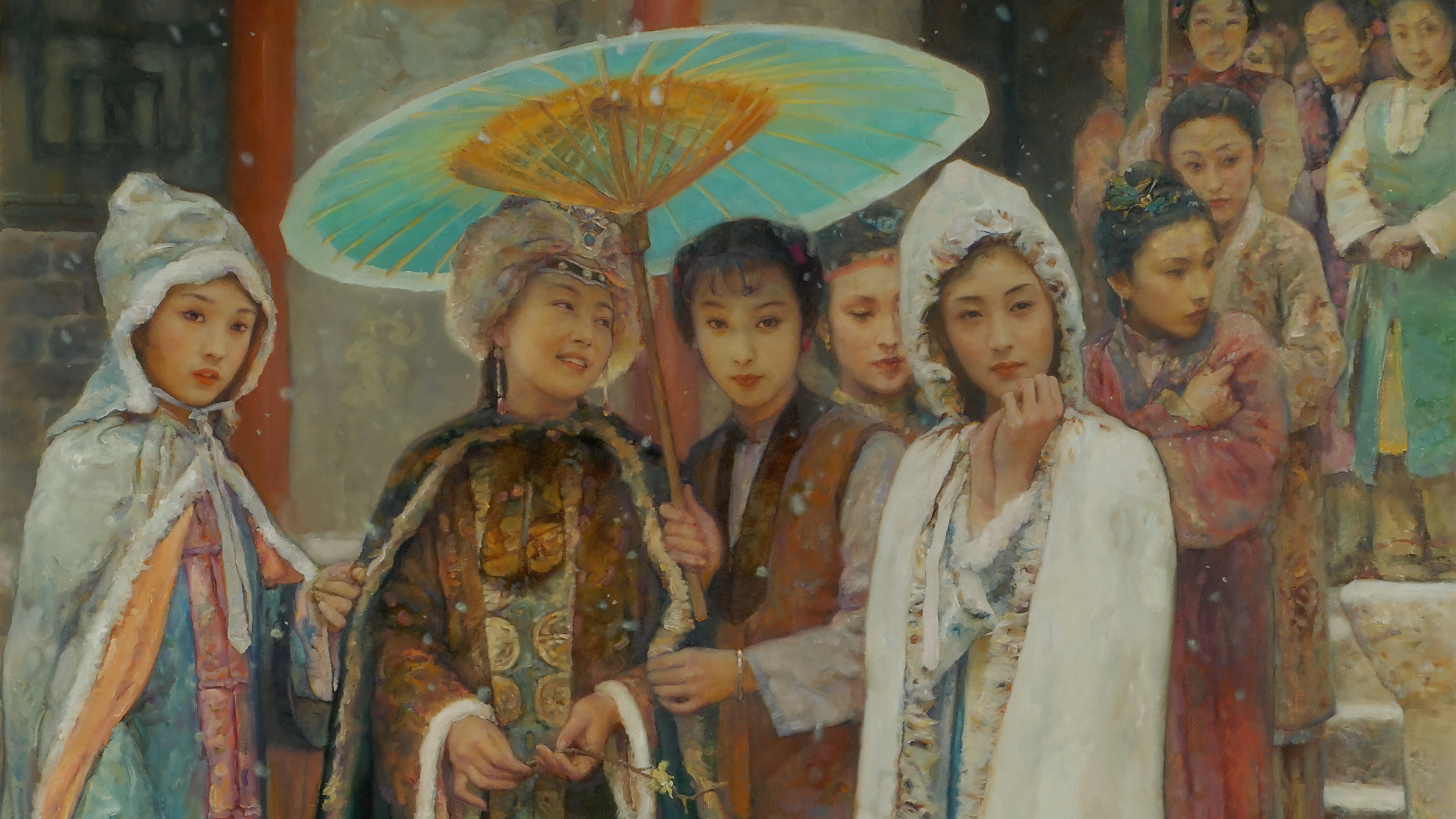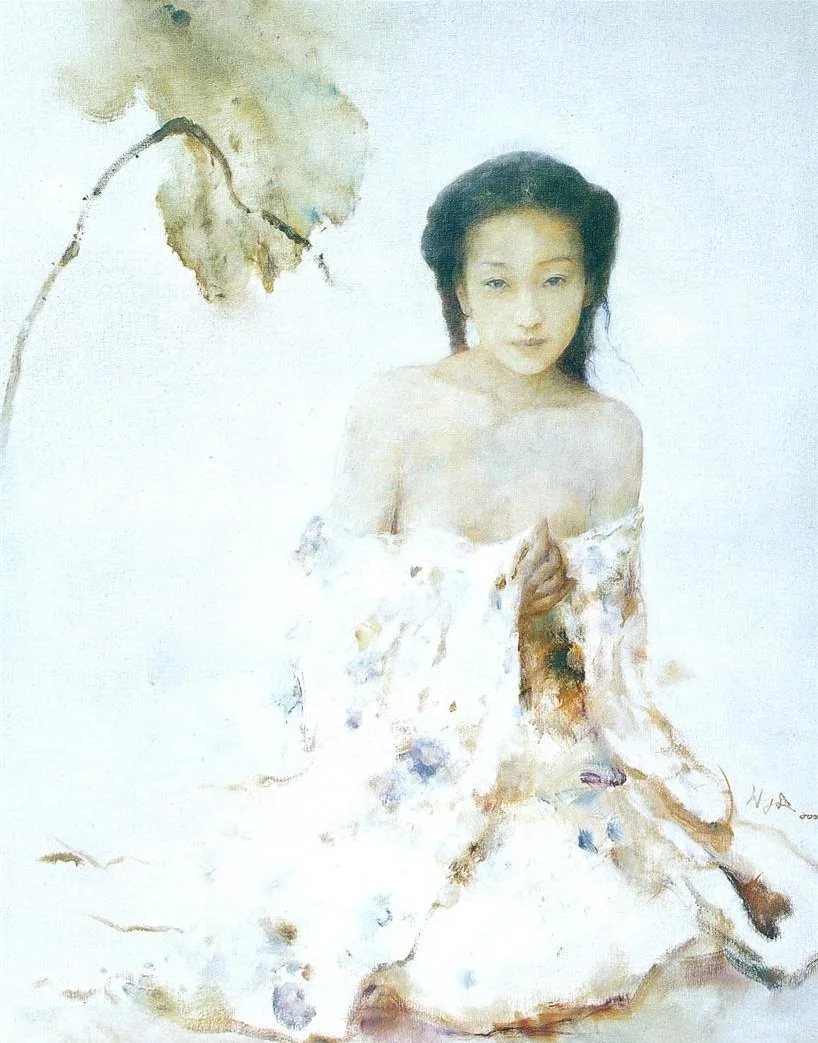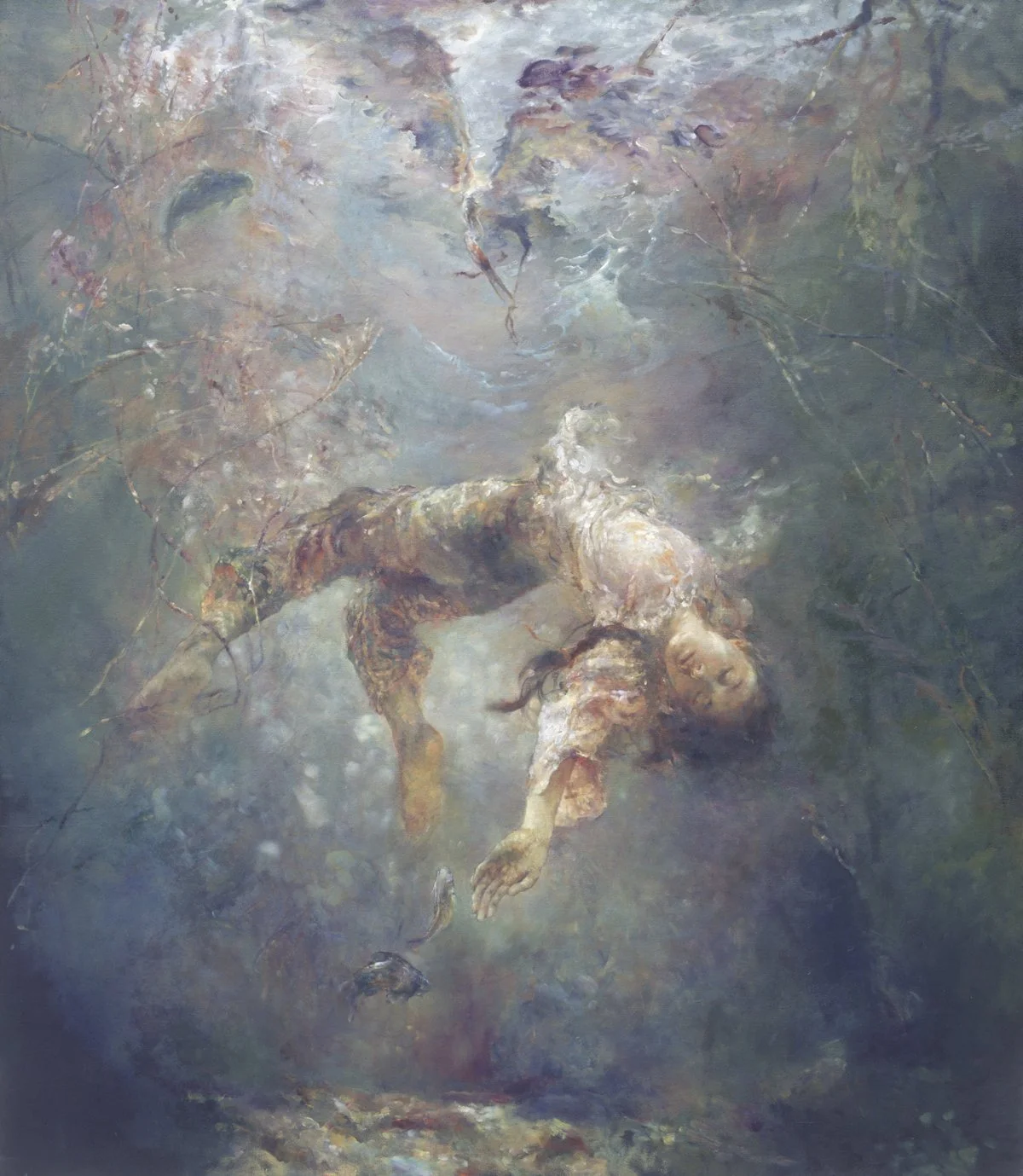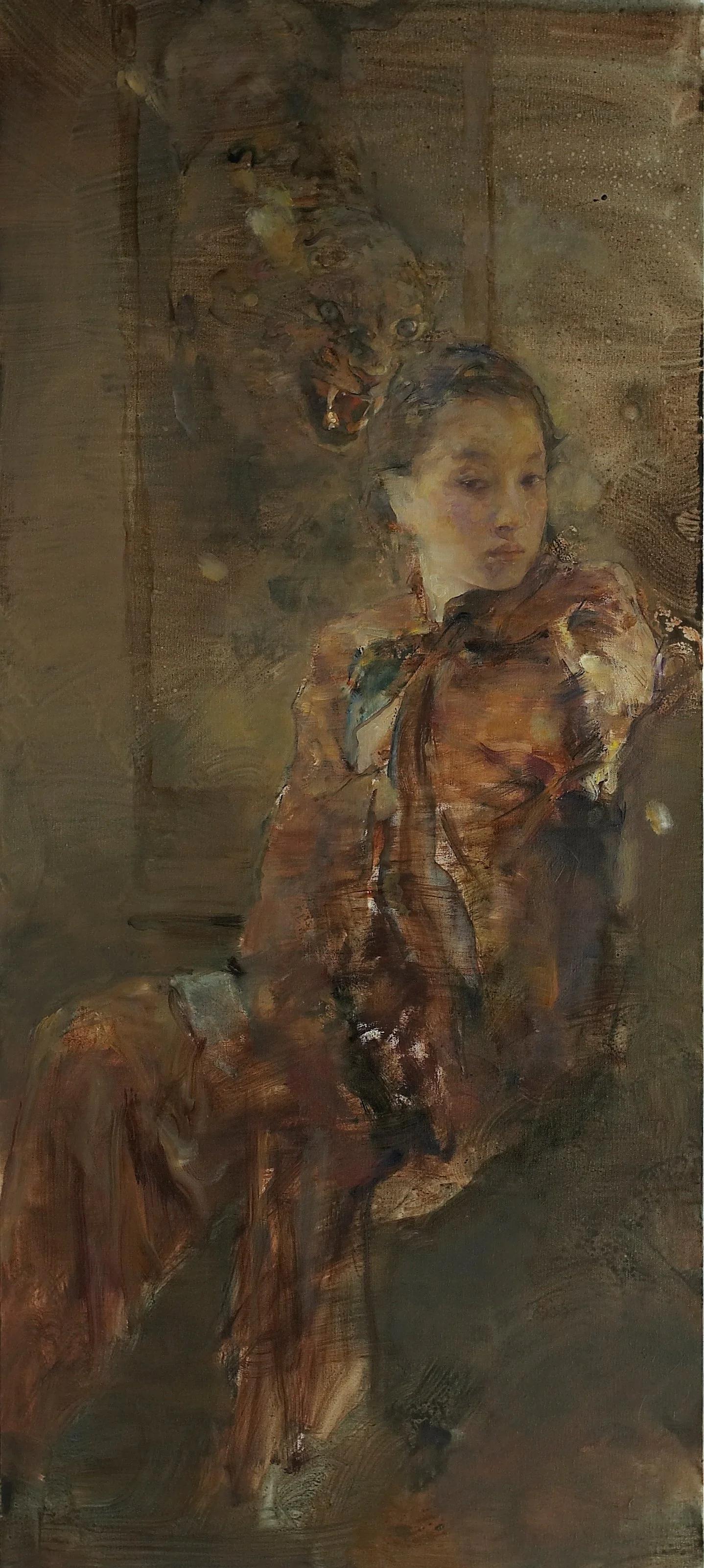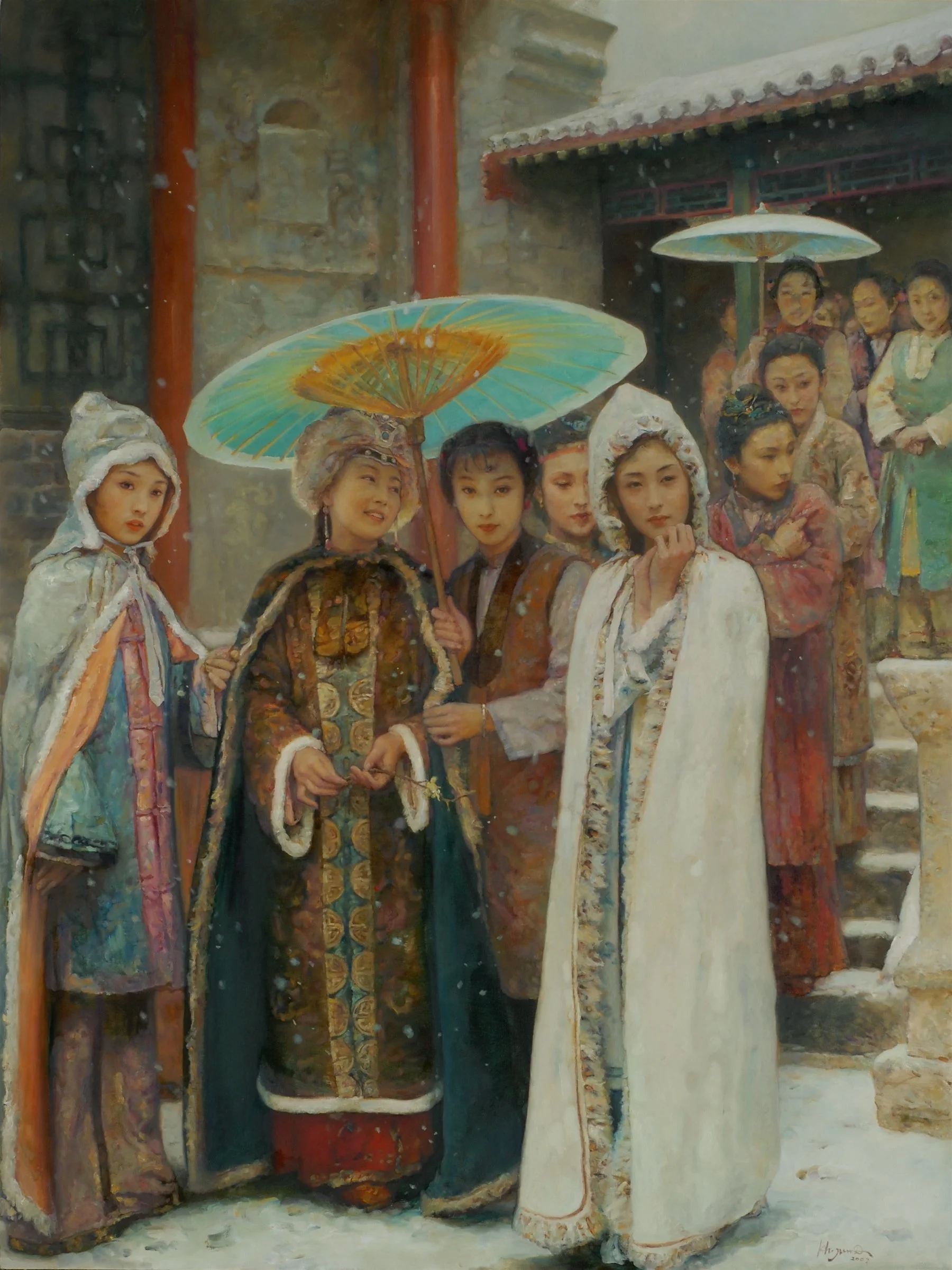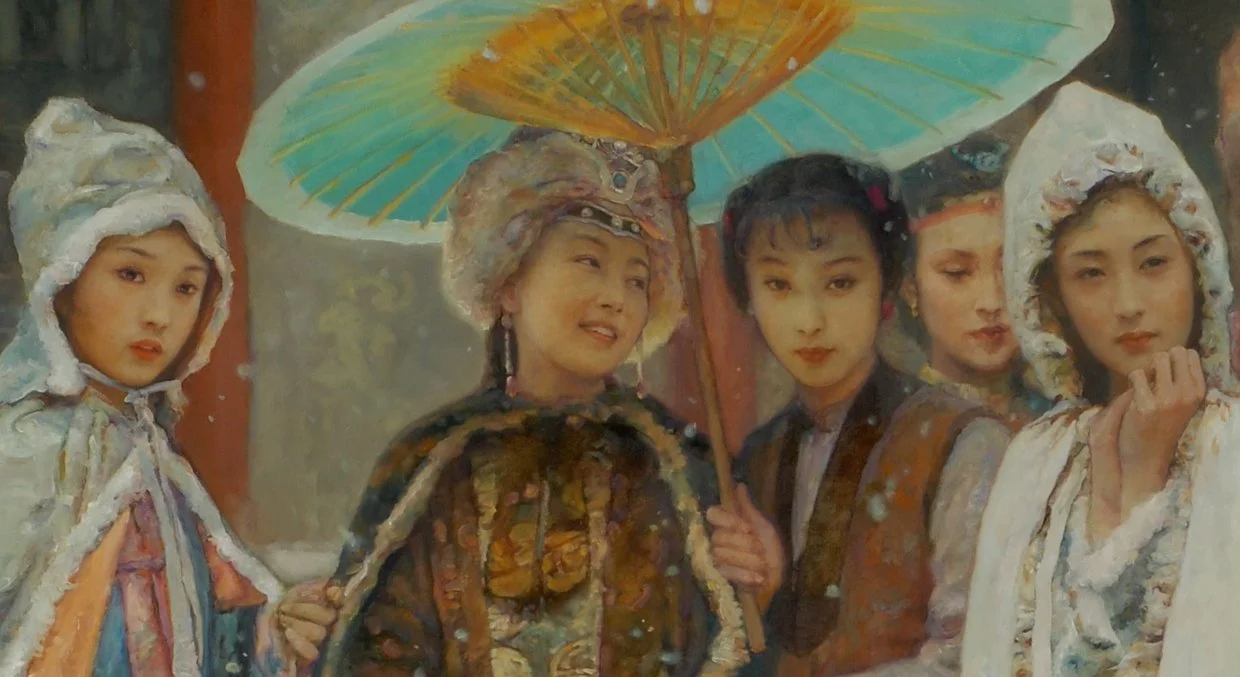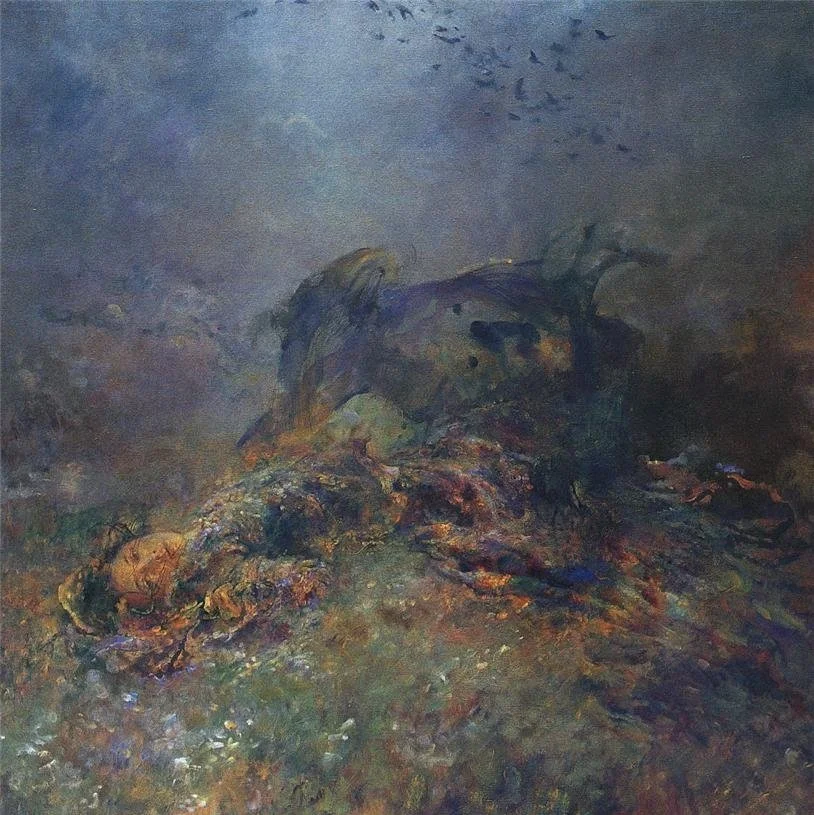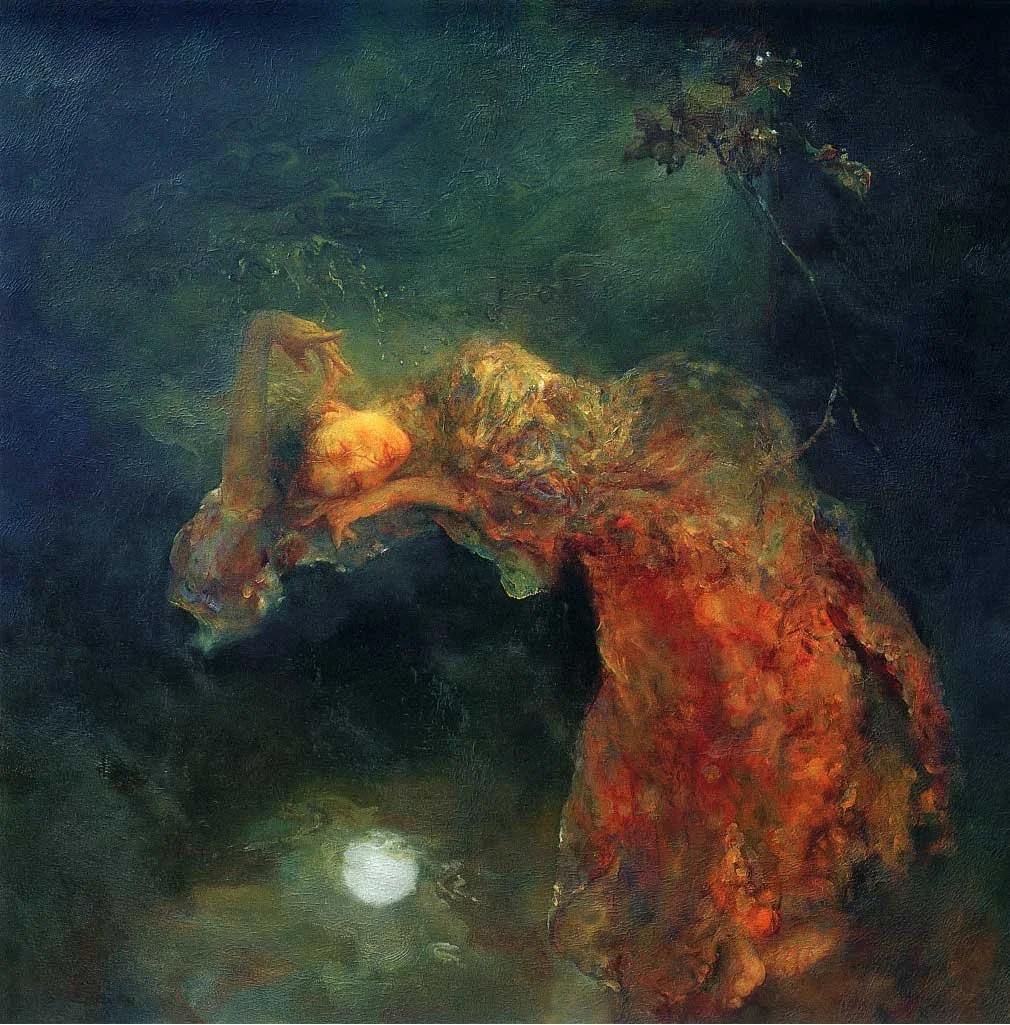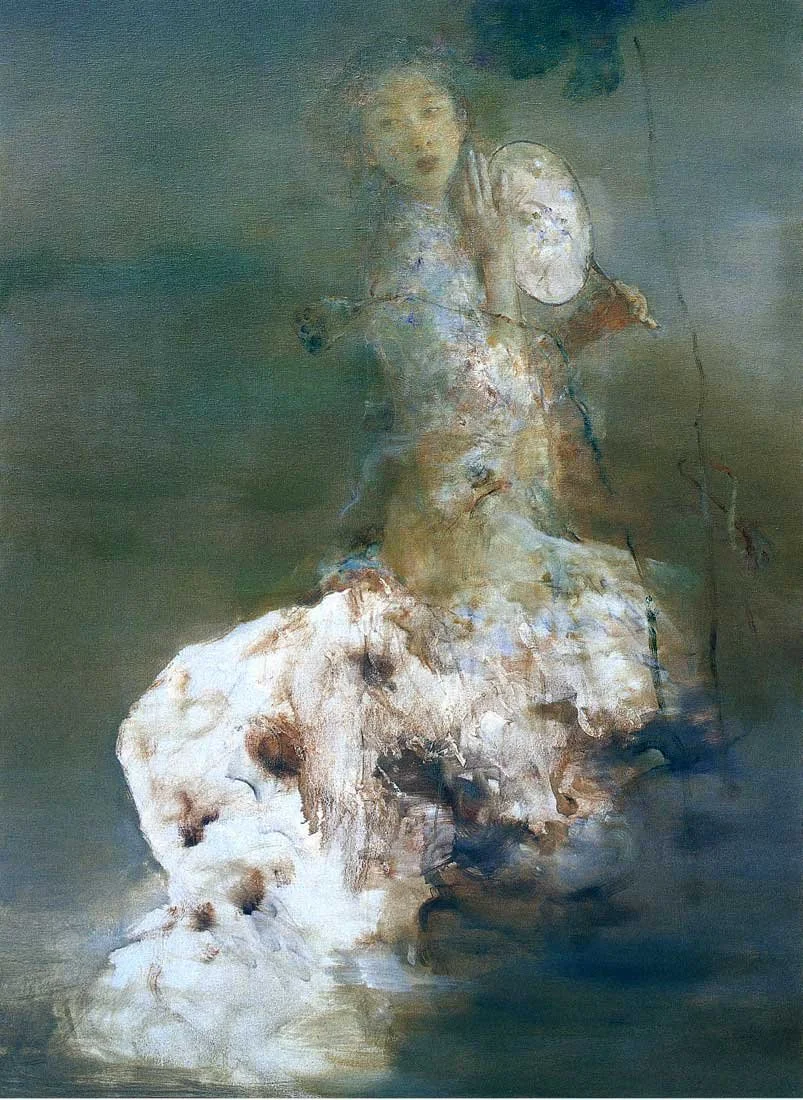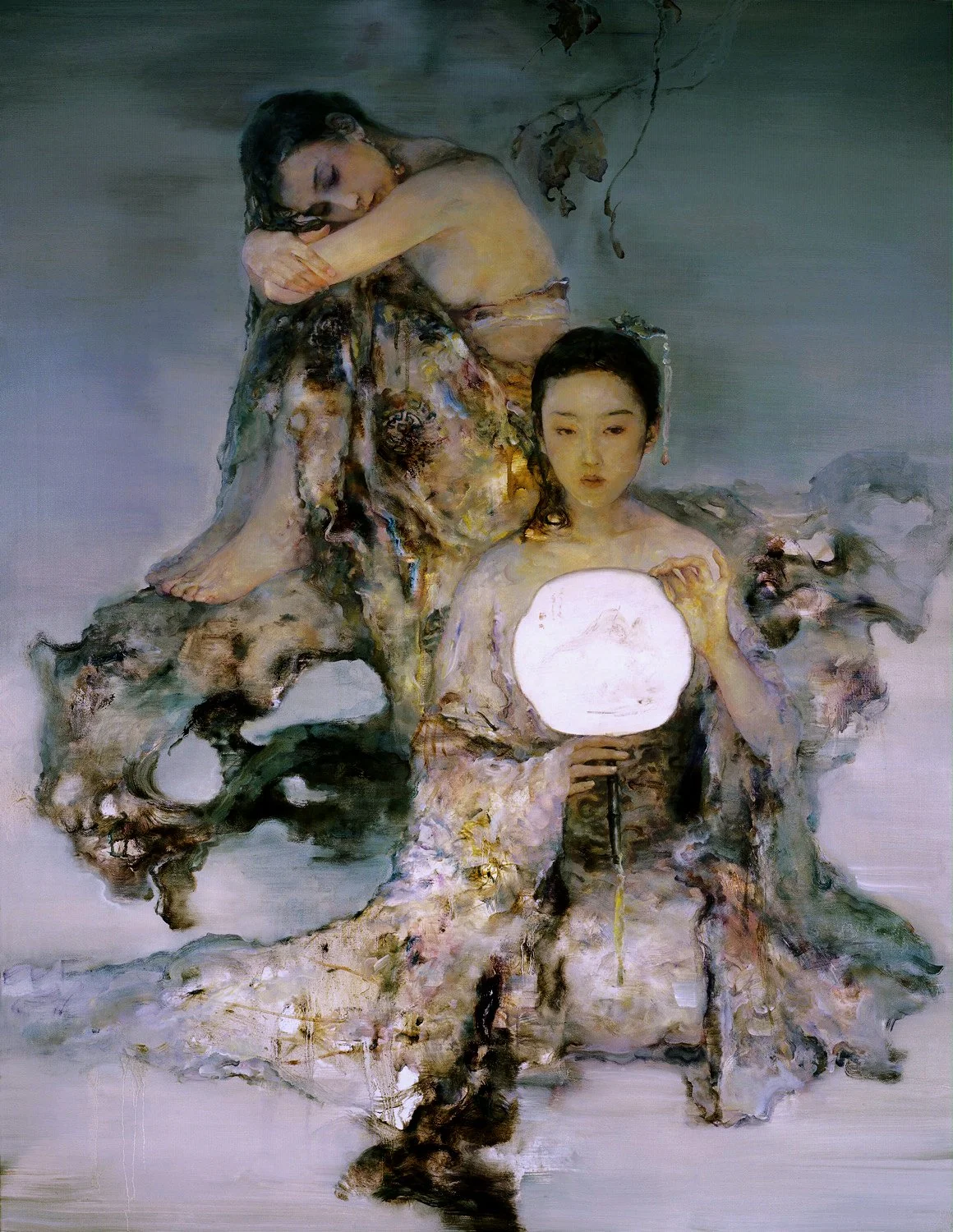Eternal Harmony
Eternal Harmony
Hu Jundi is an extraordinary artist who has risen above social and political oppression to realize his dreams.
O ften depicting elegant and serene women in traditional Chinese dress, Hu Jundi's subjects are composed in soft and subtle colors, held within an atmosphere of warmth and wetness that evokes the natural landscape of his native Sichuan. Appearing pure, gentle, and kind, they bear all the traits and virtues of the classical Chinese woman.
Such details are natural reflections of the world in which Hu works and lives... yet the source of their creative expression ultimately lies deeper within Hu himself—rather than using live models, he paints his characters directly from his own mind; searching for a poignant memory of someone in his life, and translating this inner vision onto the canvas.
This ability to capture the living energy of a moment –the essence of Chinese painting skill– combined with Hu's deep knowledge of both Eastern and Western artistic traditions, is the culmination of the unique and compelling journey of an artist who has, in spite of the social and cultural pressures of the world around him, found a way to invoke and express an ineffable, almost mystical realm of beauty that lies beyond the limits of place and time.
LEARNING IN SECRET
My country was in the middle of a cultural revolution when I was born. This was a very difficult period in China’s history, filled with both excitement and corruption; millions of people were throwing themselves into the creation of a new social order, and there was much political propaganda that used emotions such as fear and shame to control society.
During this time I lived with my family in a factory. I remember many days I could barely fill my stomach, and educational materials were extremely scarce as well… because of this, I didn’t learn to read until after I was a child. Yet it was within these circumstances that my earliest efforts to create art were also born...
I spent most of my days alone in the corners of the factory’s housing facility, which was usually empty due to the adults and other children being off at work or school, making it feel like a ‘dead city’. To pass the time, I instinctively began to take pieces of charcoal and sketch on the wall, which I think helped me feel more safe and at peace in this environment.
One day while I was drawing, I remember suddenly being startled by the sound of a sigh behind me. When I turned around, I saw a middle-aged man in glasses, that had apparently noticed me writing. He looked at what I had drawn with a smile, and asked me if I would like to come with him to his home.
When we entered his house, he took out paper and pencils and began to teach me how to draw. In the evening when my parents returned from work, I was so happy to tell them about this new experience I had been shown!
Now it’s important to mention that during this time, laws stated you were only allowed to make art privately in your home, and only specific types of art that were in positive support of the Communist Party. So in the eyes of the authorities, this painter who taught me how to draw would have undoubtedly been labeled as a ‘bad guy’.
Yet I was attracted to the extremely scarce emotion of love that he emanated, and always returned to knock on his door to learn more from him, risking being punished or even beaten, until one day he disappeared without saying goodbye.. so looking back, I have these brief but fond memories of him.
Later, when I was the age of nine, my mother introduced me to an amateur artist in the factory. He was shy and not very communicative, but thoughtful and kind, and played an important role in my artistic growth. He was different from other painters in China who at the time had become political propaganda tools.
He was trained in the Russian School of painting, and although learning foreign painting techniques was forbidden at the time, he taught me how paint real human skulls. I knew all of this was not allowed, but I was still very excited to learn.
Later when the revolution was over and the schools opened again, I was invited to study at a very prestigious art college, but in the end decided to choose a smaller school that was closer to home. I believe this was an important decision for me, because the college I attended taught a wide range of classes such as music, dance and philosophy, which allowed me to develop independent thinking and diverse ways of expressing myself. I feel this helped me to unite the Eastern and Western artistic traditions in my work.
After I completed my studies I chose to begin my professional career painting in watercolors, as I was drawn to the subtlety of color blending this medium allows. Later when I chose to switch to working with oils, since my eyes had become trained to see color and light as a watercolorist, I spent many years searching for the right combination of techniques to maintain the lighter and more luminous appearance that is normally associated with watercolors.
The method I developed consists of applying many thin layers of paint to achieve a blend of color on the surface; an approach much like that of the artist Renoir. I find painting in thin layers creates a very lustrous and unique look, from which I'm able to duplicate the rich colors of the environment all around me, and in particular human skin.
Through this process I've created a 'code' or 'key' for different subject matter—for instance, I've found that skin requires 20-30 different layers of color to achieve the realistic depth I'm looking for. The sky requires 15 -20 layers for the viewer to feel it, rather than just see it.
You cannot achieve any of these effects by seeing only a surface color. For example, when you take a close look at any part of my work that looks like a solid patch of white upon casual viewing, you will see many layers of subtle colors underneath.
INSPIRING THE IMAGINATION
For me painting is a very personal way to share the subjects of my imagination. When I was young, my mother would always recount beautiful tales and stories to me, and eventually this imaginal world found its way into my everyday life; so when I would look at something such as the moon, I wouldn’t see just the moon, but the story of 'the goddess and the moon'.
In this way I feel my mother was my biggest childhood influence because she inspired me through these stories, which later helped me develop the ability to trust my own imagination, and paint without models or photographs.
The subjects of my paintings are often women, because I think they are God's most beautiful creation, and greatest mystery!
I've also been influenced by the great literature of the world. In my early twenties at university I read a lot of books on Western philosophy, religion, and ethics, and feel this type of knowledge serves as a great resource to cultivate self knowledge and harmony in one's life. Through these studies I was particularly inspired by the idea of how one can seek out and express their own individual voice through their art.
In my late twenties I then began to read the poetry and literature of the East, and discovered I had a deep spiritual bond with these works and what they communicated to me. I find that traditional Chinese poetry and music provide me with a refuge from the pressures and corruption of everyday life... as someone once said, 'to read poetry is like being in love, and I don't want to be separated from it for a moment.'
So ultimately it is poetry, literature and history that give me the deepest insights into the nature of humankind, and serve as the main sources of inspiration in my work.
The Girl and the Crane
STORIES
For example this painting, titled ‘Girl and the Crane’, is based on a story from Liao Zhai, a famous book of Chinese fairy tales and ghost stories written hundreds of years ago by Pu Songling. Many of its stories were about forbidden love between men and beautiful women who had transformed into humans from foxes or other spirits. 'Girl and the Crane' is a story in which a girl was punished for forbidden love, and sunk into the bottom of the ocean. Her lover then turned into a crane to rescue her, and they lived happily ever after.
With this piece I sought to create a tranquil and dreamy world where the girl is melting into the water as if dancing, and at the same time is floating peacefully and resigned... heartbreakingly beautiful. I didn't want to give an impression of struggle or suffering in the face of death, only beauty and serenity, with a touch of sadness, made even more magnificent through the redeeming power of life.
BEAUTY AND THE BEAST.
‘Beauty and the Beast’ is a work that is based on another ancient Chinese book, titled Mountains and Seas. This book is more than 2000 years old, dating from the pre-Qing era (2100BC to 221BC). The great Chinese philosophers Confucius and Laozi (author of the Tao Te Ching) were also from this time.
This amazing book is filled with ancient Chinese mythology, geology, religion, medicine, witch craft, stories about the mystical powers of birds and other animals, and the concept of Yin (阴) and Yang (阳), which means female and male.
Chinese people believe there is no Yin without Yang, and vice versa, and imbalance between the two causes chaos and misfortune. Yang is born from Yin, and Yin is nourished and protected by Yang.
This explains the ethereal female in the forefront of the painting: her otherworldly beauty and serenity balance the fierce looking creature in the background... a leopard, which symbolizes swiftness, vigor, courage, and strength—the qualities of a fierce warrior.
From this perspective, beauty would be an incomplete picture without the presence of the beast, and vice versa. It's the power in the unity of Yin and Yang, the origin of all life.
First Snow
The painting ‘First Snow’ is inspired by the masterpiece of Chinese literature Dream of the Red Chamber by Cao Xueqing from the Qing Dynasty (18th century).
This novel provides a detailed, episodic record of the Jia Clan, the most illustrious clan in the capital of Nanjing, during the fall from the height of its prestige. The name of the main family, 'Jia' has the same pronunciation in Mandarin as false, fake, or deceitful. The author suggests this family is in some ways a 'dream' version of his own, making the novel a mixture of real and illusory storytelling.
The plot has supernatural Taoist and Buddhist overtones—a sentient stone, abandoned by Nuwa when she mended the heavens eons ago (the goddess of the Chinese genesis), begs a Taoist priest and Buddhist monk to take it to see the world, and then falls in love with a Crimson Pearl Flower, which causes it to enter the mortal realm.
The main character Jia Baoyu (precious stone), born with a piece of luminescent jade in his mouth, is the adolescent heir of the family, and possibly a reincarnation of the Stone. The Crimson Pearl Flower is incarnated now as Baoyu's sickly cousin, the emotional Lin Daiyu. Yet Baoyu is predestined in this life to marry another cousin, Xue Baochai. This love triangle set against the backdrop of the family's declining fortunes forms the most well-known plot line in the novel.
The three main characters in this painting are Jia Mu (the royal grandmother and matriarch of the clan), who stands in the middle sheltered by the umbrella; Lin Daiyu (the Crimson Pearl Flower), who stands on the right and is dressed in a white hooded cape; and the cousin Xue Baocai, who stands to the left and wears a teal green hooded cape.
The phrase 'Red Chamber' was an idiom for the sheltered chambers where the daughters of wealthy families lived. Red also suggests the Buddhist idea that the whole world is 'red dust,' merely illusory and to be shunned. Thus the novel fits in perfectly with Buddhist and Taoist beliefs that to attain enlightenment, one must realize that the world is but a dream from which we must awake.
In ‘First Snow’ I was inspired to bring the amazing cast of characters from this story to life. I painted the scene and costumes of that era, and tried to accurately depict the expressions and sprit of these colorful individuals who lived some 300 years ago.
THE RAIN, THE WIND AND THE CLOUDS
China is also a very old country, having over 5000 years of incredibly rich history, culture, and wisdom. Yet today, much of this is being eroded by the 'me first' messages so prevalent in the Western entertainment culture that's been adopted here. Such purely materialistic values have created the era of personal and social alienation we now live in, which raises important questions about how to realize one's true value and place within this world.
I feel on a deep level many Chinese people today are experiencing discomfort and anxiety trying to live within the current model of society, and think there may emerge a longing to return to deeper values historically represented by the principles of Confucian order, and the harmony of Taoism. As an artist I feel a responsibility to address these issues, and help promote real social change and cultural transformation through my work.
Throughout my life I've never chased after fads, or abided by the rigid rules of tradition; there've been many challenges, and much of my early work was censored or destroyed because it didn't adhere to the government's standards of social order.. yet through perseverance I feel I've grown beyond these limitations to create something that is both old and new, Eastern and Western, that may perhaps serve as an example of a way forward.
For I truly believe art has the power to carry us beyond the mundaneness of ordinary life, and bring us closer to the essential spirit of our existence. It offers a fresh space within which life may emerge anew, allowing the unfamiliar to become familiar, and the invisible to be seen... in this way I'd say my paintings are like the rain, the wind and the clouds... it's the spirit of these elements, and the harmony between them, that I hope they may awaken within others.
— Please visit: www.mandarinfineart.com for more information and collection inquiries —


